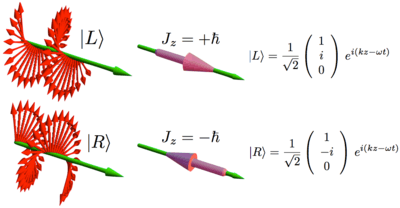Spin angular momentum of light
The spin angular momentum of light (SAM) is the component of angular momentum of light that is associated with the quantum spin and the wave's circular or elliptical polarization.
Introduction

An electromagnetic wave is said to have circular polarization when its electric and magnetic fields rotate continuously around the beam axis during propagation. The circular polarization is left ( ) or right ( ) depending on the field rotation direction and, according to the convention used: either from the point of view of the source, or the receiver. Both conventions are used in science depending on the subfield.
When a light beam is circularly polarized, each of its photons carries a Spin Angular Momentum (SAM) of , where is the reduced Planck constant and the sign is positive for left and negative for right circular polarizations (this is adopting the convention from the point of view of the receiver most commonly used in optics). This SAM is directed along the beam axis (parallel if positive, antiparallel if negative). The above figure shows the instantaneous structure of the electric field of left ( ) and right ( ) circularly polarized light in space. The green arrows indicate the propagation direction.
The mathematical expressions reported under the figures give the three electric-field components of circularly polarized plane wave propagating in the direction, in complex notation.
Mathematical expression
General expression for the spin angular momentum in the paraxial limit is[1]
where and are the electric field and magnetic vector potential respectively, is the vacuum permittivity, and we are using SI units.
Monochromatic-wave case:[2]
In particular, this expression shows that the SAM is nonzero when the light polarization is elliptical or circular, while it vanishes if the light polarization is linear.
In the quantum theory of the electromagnetic field, the SAM is a quantum observable, described by a corresponding operator:
where is the unit vector in the propagation direction, and are respectively the creation and annihilation operators for photons in the mode k and polarization state .
In this case, for a single photon the SAM can only have two values (eigenvalues of the SAM operator):
The corresponding eigenfunctions describing photons with well defined values of SAM are described as circularly polarized waves:
See also
References
- ↑ Belintante, F. J. (1940). "On the current and the density of the electric charge, the energy, the linear momentum and the angular momentum of arbitrary fields". Physica. 7 (5): 449. Bibcode:1940Phy.....7..449B. doi:10.1016/S0031-8914(40)90091-X.
- ↑ Humblet, J. (1943). "Sur le moment d'impulsion d'une onde electromagnetique". Physica. 10 (7): 585. Bibcode:1943Phy....10..585H. doi:10.1016/S0031-8914(43)90626-3.
Further reading
- Born, M. & Wolf, E. (1999). Principles of Optics: Electromagnetic Theory of Propagation, Interference and Diffraction of Light (7th ed.). Cambridge: Cambridge University Press. ISBN 0-521-64222-1.
- Allen, L.; Barnnet, Stephen M. & Padgett, Miles J. (2003). Optical Angular Momentum. Bristol: Institute of Physics. ISBN 978-0-7503-0901-1.
- Torres, Juan P. & Torner, Lluis (2011). Twisted Photons: Applications of Light with Orbital Angular Momentum. Bristol: Wiley-VCH. ISBN 978-3-527-40907-5.